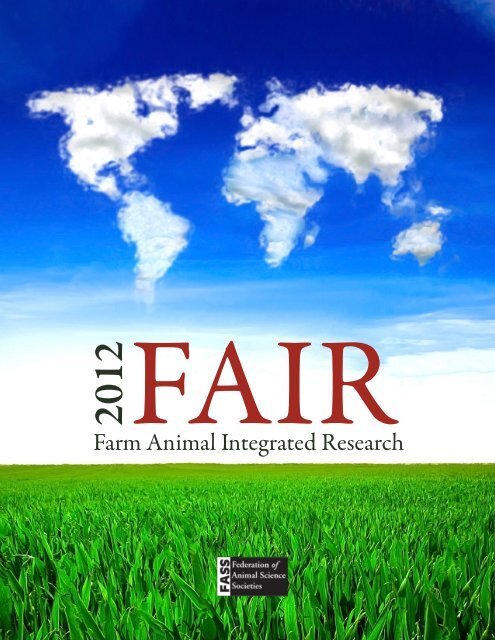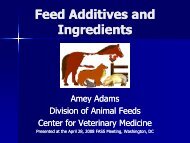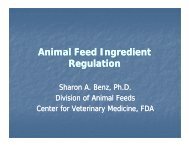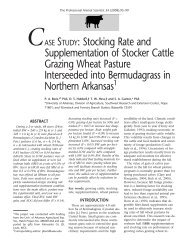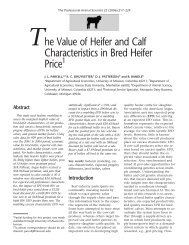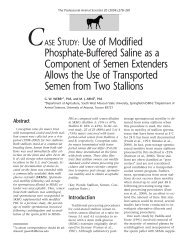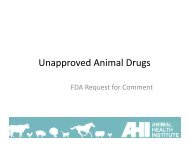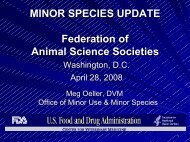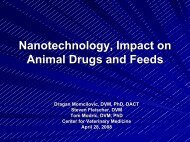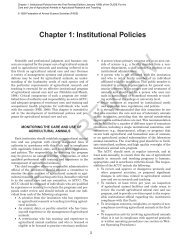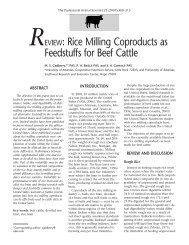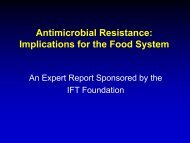outcomes document - Federation of Animal Science Societies
outcomes document - Federation of Animal Science Societies
outcomes document - Federation of Animal Science Societies
You also want an ePaper? Increase the reach of your titles
YUMPU automatically turns print PDFs into web optimized ePapers that Google loves.
FAIR 2012Table <strong>of</strong> ContentsFarm <strong>Animal</strong> Integrated Research (FAIR) 2012 Executive Summary. ................................ 3Preamble. ........................................................................... 3Major Focus Areas and Priorities. ......................................................... 3Crosscutting Issues .................................................................... 3Conclusions. ......................................................................... 3FAIR 2012: Final Synthesis and Introduction <strong>of</strong> Priorities. ........................................ 4Summary <strong>of</strong> Conference Plenary and Breakout Sessions. .......................................... 6Theme 1: Economic Growth and Environmental Sustainability .................................. 6Theme 1: Research and Education Priorities Identified. ........................................ 7Theme 2: <strong>Animal</strong> Agriculture in Society and the Global Marketplace. ............................. 7Theme 2a: <strong>Animal</strong>s in Society. ........................................................... 8Theme 2b: Factors Influencing the Global Marketplace. . . . . . . . . . . . . . . . . . . . . . . . . . . . . . . . . . . . . . . . 8Theme 2: Research and Education Objectives Identified. ...................................... 10Theme 3: One Health—Healthy <strong>Animal</strong>s, Healthy People, Healthy Planet. ........................ 10Theme 3: Research and Education Objectives Identified. ...................................... 12Crosscutting Themes Emerging from FAIR 2012. .............................................. 13Strategic Directions <strong>of</strong> FAIR 2012. ....................................................... 13Focus Area 1: Food Security. ......................................................... 13Focus Area 2: One Health. ........................................................... 14Focus Area 3: Stewardship ........................................................... 14Crosscutting Issues ................................................................... 15Conclusions. ........................................................................ 152
FAIR 2012FAIR 2012: Final Synthesis and Introduction <strong>of</strong> PrioritiesAt the culmination <strong>of</strong> a yearlong effort to develop a national forum<strong>of</strong> scientists, educators, industry personnel, health pr<strong>of</strong>essionals, andgovernmental representatives, we find that the premise for findingconsensus on research, educational, and outreach priorities remainsremarkably similar to that identified in a similar exercise undertakenin 1998 and published in 2002 (FAIR, 2002). At that time, the focuswas on scientific animal agriculture, competitive farmers and ranchers,safe and nutritious food, improved animal health, and enhancedenvironmental stewardship. In 2002, these needs motivated a call forenhanced public investment in research and education to fuel the“creation <strong>of</strong> industries and export pr<strong>of</strong>its that sustain communitiesand rural economies across the country” (FAIR, 2002). The sights in2002 were clearly focused on US agricultural issues.The stakes in 2012, however, and the arena in which those stakeswill play out, are vastly different from those identified in 2002.Then, the US economy was strong and growing, and the UnitedStates was the leading exporter <strong>of</strong> animal protein to the rest <strong>of</strong> theworld. Since then, the worldwide economy has faced tremendouschallenges. Although the United States is on pace to have recordexports <strong>of</strong> animal protein in 2012, the country no longer leads inall major categories <strong>of</strong> animal protein exports. At the same time,other countries have expanded their exports and taken a prominentplace on the world agriculture stage. The world population reached7 billion recently, and global projections suggest 9 billion people by2050—an astronomical number that will double the need for foodand increase competition for limited resources.That competition, in combination with climate change, loss <strong>of</strong> biodiversity,and degradation <strong>of</strong> resources (Foley et al., 2011), will bejuxtaposed against the survival <strong>of</strong> the planet itself, and so publicinvestment in research and education is more critical than ever.Pardey and Alston (2010) make a compelling case for agriculturalproductivity research based on rate <strong>of</strong> return (benefit:cost ratios <strong>of</strong>up to 20:1), reduction <strong>of</strong> food production costs, and greater accessto food by the poorest people, who spend the greatest proportion <strong>of</strong>their income on food. Foley et al. (2011) suggest a number <strong>of</strong> scenariosby which increased food production and decreased environmentalharm from agriculture can co-exist; and Foley (2011) proposes afive-step plan by which we can achieve food production goals whilereducing environmental damage. Clearly, the sights in 2012 must befocused globally.In considering these issues and the provocative talks and discussionsthat occurred at FAIR 2012, game changers are clearly needed as wepropose research priorities for the next decade and beyond. Fundingfor agricultural research has stagnated due to budgetary challengesand a lack <strong>of</strong> understanding <strong>of</strong> the importance <strong>of</strong> food and the environment.A breakdown in the interconnectedness between livestockand crop production could easily have a disruptive and game-changingimpact on public health and societal well-being. Climate change,catastrophic weather events, governmental breakdowns, overzealousprecautionary regulations, war, and other societal upheavals arepotential contributors. Globally, we are all in this together and weneed to ensure that the linkages do not break; the United States musttake a lead role in this.Another major determinant <strong>of</strong> future success will be our ability topush the frontiers <strong>of</strong> science. We must challenge our fellow scientiststo make new discoveries that will lead to significant advancesin meeting the expected demand for meat and dairy products by2050. We must attend to the pipeline at both the undergraduateand graduate levels to ensure that we meet the scientific and leadershipneeds for the future. A much deeper understanding <strong>of</strong> animalbiology and postmortem processes, coupled with rapid translation<strong>of</strong> revolutionary breakthroughs that leads to swift development andimmediate adoption <strong>of</strong> new technologies, is necessary to keep ourplanet healthy and meet the increasing global demand for animalfood products.Recent work on residual feed intake (RFI) provides evidence <strong>of</strong> substantialvariation among animals in the efficiency with which theyuse dietary energy, as well as evidence that selection can increaseenergetic efficiency. We need to understand the underlying physiologymore fully and use that understanding as a guide in applyingappropriate genetic selection. This comes with two caveats: (1)animals must not become more efficient by becoming fatter; and(2) selection for low RFI may adversely affect immune function.Many vaccines are less effective than we would like them to be, andadvances in vaccinology could lead to more effective vaccines. Thisis important in the United States but perhaps even more importantin the developing world. It may also be especially important in aquaculture.Some applications may not be related to diseases: a currentexample is immunocastration, but there may be other approaches touse vaccines to alter physiology and productivity.A balanced approach to funding and conduct <strong>of</strong> research is alsoneeded. Currently, with the creation <strong>of</strong> the National Institute <strong>of</strong>Food and Agriculture (NIFA), huge multidisciplinary grants are theorder <strong>of</strong> the day. Although multidisciplinary and transdisciplinaryresearch is critical, not all sound research adapts easily to the currentformat for proposals. Funding streams should be considered,and increased funding for agriculture research by agencies other thanthe USDA is imperative. With the historical rate <strong>of</strong> return (20:1)on investment in agricultural research, the USDA must examine itsfunding structure and ensure that the maximum return on investmentis not impeded by governmental restrictions.4
FAIR 2012ReferencesFAIR (Farm <strong>Animal</strong> Integrated Research). 2002. <strong>Animal</strong> Productsfor the Next Millennium—An Agenda for Research and Education.http://www.fass.org/fair2002.pdf. <strong>Animal</strong> Agriculture Coalition,Washington, DC, and <strong>Federation</strong> <strong>of</strong> <strong>Animal</strong> <strong>Science</strong> <strong>Societies</strong>,Champaign, IL.Foley, J. A. 2011. Can we feed the world and sustain the planet? Sci. Am.305:60–65. http://dx.doi.org/10.1038/scientificamerican1111-60.Foley, J. A., N. Ramankutty, K. A. Brauman, E. S. Cassidy, J. S.Gerber, M. Johnston, N. D. Mueller, C. O’Connell, D. K. Ray,P. C. West, C. Balzer, E. M. Bennett, S. R. Carpenter, J. Hill, C.Monfreda, S. Polasky, J. Rockström, J. Sheehan, S. Siebert, and D.Tilman, and D. P. M. Zaks. 2011. Solutions for a cultivated planet.Nature 478:337–342. http://dx.doi.org/10.1038/nature10452.Pardey, P. G., and J. M. Alston. 2010. For want <strong>of</strong> a nail:The case for increased agricultural R&D spending. AmericanBoondoggle: Fixing the 2010 Farm Bill. Accessed April 19, 2012.http://www.aei.org/AmericanBoondoggle.5
FAIR 2012Summary <strong>of</strong> Conference Plenary and Breakout SessionsTheme 1: Economic Growth and EnvironmentalSustainabilityThe issues surrounding the question <strong>of</strong> mutual compatibility <strong>of</strong> economicgrowth, environmental sustainability, and the ability to feed anexploding population have been highly controversial and hotly debatedover the past decade or so. In order for the global economy to growand prosper on the gross domestic product (GDP) scale, more goodsand services are necessary each year; in this country, we need economicgrowth to ensure that our standard <strong>of</strong> living continues to increase. Onthe other hand, there are global considerations, where increases in thestandard <strong>of</strong> living in many countries are directly linked to access toanimal protein. The production and distribution <strong>of</strong> animal protein—with its attendant issues <strong>of</strong> grain production, water distributionand availability, global climate change, and finite acres <strong>of</strong> arableland—are among the major issues facing us that must be addressedwith new ways <strong>of</strong> thinking. Beginning with Robert Malthus in the1700s, many subscribe to the theory that economic growth and sustainabilityare incompatible. The Malthusian concept was based onthe notion that population growth is always exponential, whereasfood production is arithmetic. Thus, according to this reasoning,sustainability can only be achieved by population control. Malthus,however, reckoned without the insight that technology would interveneand move food production from the arithmetic to the exponentialgrowth curve. It is thanks to agricultural research fundedprimarily through the USDA at land-grant universities that thediscrediting <strong>of</strong> Malthus’ theory concerning the question <strong>of</strong> populationgrowth and sustainability through food production has beenpossible.The relationship between environmental quality and economicdevelopment is explained by the hypothetical environmentalKuznets curve: as income goes up, environmental health decreases toa point and then improves. With regard to several indicators <strong>of</strong> environmentalhealth, this inverted U-shaped curve does appear to hold;for example, water and air pollution based on reductions in levels<strong>of</strong> sulfur dioxide, nitrogen oxide, lead, DDT, chlor<strong>of</strong>luorocarbons,and so on. However, energy, land, and resource use (the ecologicalfootprint) do not appear to follow the environmental Kuznets curve;that is, these indicators do not decrease with increasing incomes.Greenhouse gases have continued to increase and the degradation <strong>of</strong>ecosystem services has continued to decrease in developed countries.In addressing the questions <strong>of</strong> increased food production and environmentalsustainability, the focus on improvements in efficienciesin animal production systems is critical. Nontraditional technologiesand technologies that have not yet surfaced will drive improvementsin animal production efficiency in the future. To paraphraseAlbert Einstein, “we cannot solve problems by using the same kind<strong>of</strong> thinking we used when we created them.” It is imperative that wenot rely on past practices or we could be in direct conflict with ourdesired <strong>outcomes</strong>.The challenges that will continue within the animal productionsector include• Air quality;• Water quantity, quality, and distribution;• Available land resources;• Carbon footprint <strong>of</strong> food production.Local, state, federal, and international policies and regulations willplay key roles in• Cost structures,• Development technologies,• Application technologies, and• Economic understanding <strong>of</strong> a combination <strong>of</strong> the above.As we evaluate these key factors, we must invest in sound scientificinquiry in order to develop relevant models that can be used toinform future policies and regulations.A good example <strong>of</strong> ways in which sound science can inform relevantpolicies is development <strong>of</strong> concentrated animal feeding operations(CAFO) regulations by the US Environmental Protection Agency.The tools to measure quality characteristics for environmental concernscontinue to become more specialized for specific compoundsand allow for more precise units <strong>of</strong> measurement. Research needsto continue to give regulators and animal producers a much clearerunderstanding <strong>of</strong> the multiple reactions and end-product compoundsthat affect the environment. Research is needed to providethe federal government and industry sound information about compoundsthat must be measured in real time versus those that can bemonitored over time. Data from CAFO monitoring must be aggregatedand understood as a whole over the face <strong>of</strong> animal production.Falling short <strong>of</strong> this goal will result in misinformed regulations thatburden the livestock industry.Game-Changing Research Is NeededGoing forward, a number <strong>of</strong> game-changing research areas mustemerge as drivers. Systems research and comprehensive managementprograms must focus on reducing inputs per unit <strong>of</strong> productionoutput. Efficiencies <strong>of</strong> animal water and feed utilization, bothlatent and overt, must be at the forefront. Examples <strong>of</strong> research toaddress efficiencies include animal energetics, feedstuff analysis,genetic development for greater digestibility and nutrient delivery,and metabolic and complex biochemical pathways. To accomplishthis, our universities and government laboratories must revert to thebasic sciences and ask the following questions:• What is this process or reaction and what could happen ifinput changed?6
FAIR 2012<strong>of</strong> replacement scientists, the United States and US-based companieswill be at an increasing disadvantage in the global competition fornew consumers and for maintaining US consumers and employment.Keeping that in mind, our educational priorities should ensure thatstudents are attracted to, and have opportunities for gaining experiencein, animal agriculture. Many agriculture students today comefrom urban backgrounds, with fewer than 2% <strong>of</strong> the US populationhaving a farming background. Furthermore, considering the terminologyused in political and marketing arenas can help the publicbetter understand policy and funding needs.In general, the USDA is seen as a credible source <strong>of</strong> informationby the public. For a variety <strong>of</strong> reasons, however, USDA funding foragricultural research has lagged behind federal funding <strong>of</strong> agenciessuch as the National <strong>Science</strong> Foundation (NSF) and the NationalInstitutes <strong>of</strong> Health (NIH). Industry commodity groups haveattempted to step into the breach to some extent but that is <strong>of</strong>tenseen as self-serving. The USDA must step up to defend food productionas a vital component <strong>of</strong> long-term global sustainability and towork to increase funding levels for research in support <strong>of</strong> that effort.Theme 2a: <strong>Animal</strong>s in SocietyThis sub-theme addressed a wide-ranging and complex set <strong>of</strong> circumstancesand interactions from companion animals that areincreasingly too close to people, to livestock and food animals thatare increasingly disconnected from people.Companion <strong>Animal</strong>s (Primarily Cats and Dogs): Statusin Society and Areas for Research and Education:1. Increasing focus in animal science departments, used forrecruiting for animal agriculture;2. Tremendous increase in societal emphasis on humanizingcompanion animals (designation as guardians <strong>of</strong> pets,naming pets as beneficiaries <strong>of</strong> wills);3. Disclaimers in movie credits regarding lack <strong>of</strong> actual harmto animals in films (this is not the case with simulateddeaths <strong>of</strong> people in those same films);4. Increase in medical interventions and therapies for pets;5. Increase in percentage <strong>of</strong> discretionary income spent on petneeds;6. Role <strong>of</strong> companion animals in therapy and residential carescenarios.Agricultural Nonfood Livestock (Horses): Status inSociety and Areas for Research and Education:1. Role <strong>of</strong> horses as socio-economic drivers in farm and nonfarmlifestyles;2. Role <strong>of</strong> horses as therapy animals;3. Horses as a research model for a number <strong>of</strong> human agingdiseases and disorders;4. Issues and implications <strong>of</strong> antislaughter legislation onhorse welfare.Agriculture and Natural ResourcesAgriculture and natural resources are at the center <strong>of</strong> 21st centurygoals, including1. increasing global agricultural productivity;2. a growing global population in a closed system;3. a recognition <strong>of</strong> links between local and global food security,health, poverty, and social/political stability;4. increased demand per capita for food, water, fiber andenergy—trade<strong>of</strong>fs loom large; technologies for improvingefficiencies.Societal Shifts1. Increased call for decreasing the environmental footprint<strong>of</strong> production;2. Competition for energy sources and feedstuffs for alternativeenergy production;3. Increased attention to animal well-being and welfare, leadingto regulation <strong>of</strong> process;4. Historical identity <strong>of</strong> product;5. Increased purchasing power for nontraditionally producedproducts.Theme 2b: Factors Influencing the GlobalMarketplaceTrade Barriers1. Reduction in choice <strong>of</strong> goods2. Increased prices and price security3. Focus has to be, globally, expanding our goods and servicesavailability without political interventionTraceability1. The ability to trace history, application, and/or location <strong>of</strong>a product that is received or is considered for shipment, byrecorded identification.2. Traceability has to be focused on the key words “traced”and “followed.”8
FAIR 20123. More research is needed to further define the words“traced” and “followed,” as they are not totally or clearlydefined in language outlined in the Internal Organizationfor Standardization (ISO) or Codex Alimentarius.Research Investment and Infrastructure1. Education2. Demanda. Early-career training relative to all aspects <strong>of</strong> animalresearch.b. Training must include understanding the economics<strong>of</strong> the respective research.a. Understanding <strong>of</strong> the supply/demand <strong>of</strong> the endproduct <strong>of</strong> the research.b. Understanding both the scientific and public opinionviews <strong>of</strong> the research.3. Cultural differencesa. Understanding the change in global demographicsrelative to consumer demands.4. Flexibility <strong>of</strong> change/product changea. Today’s US consumer is very driven by convenience;thus, feature products have to focus on convenience,not quality, taste, or economics.b. The lifespan <strong>of</strong> products may be shortened by changingdemands; thus, new and improved changes <strong>of</strong>products will be the norm, not the exception.Internal Relationships and Internship1. Provide pr<strong>of</strong>essional training for young scientists.2. Foster global competency.3. Reinforce academic training via practical application(based on local practices).4. Organizational relationships and international opportunitiesmust be focused on the notion that education mustinfluence people’s lives beyond the boundaries <strong>of</strong> our classroomsor laboratories.<strong>Animal</strong> Welfare and Well-Being1. Differentiate between welfare and well-being.2. The animal sector must serve as stewards <strong>of</strong> animals.3. Continued training must occur within the disciplines <strong>of</strong>welfare and well-being as they relate to all aspects <strong>of</strong> animalproduction.4. A unified set <strong>of</strong> guidelines based on sound science.Increasing Exports While Decreasing Imports1. Maintaining an optimum “balance <strong>of</strong> trade.”2. If our industry exports more product, especially valueaddedproduct, the industry will be receiving more dollarsfrom abroad than it is sending abroad.3. It is imperative that tariffs are monitored, because if tariffsare placed on goods, consumers and businesses will reducethe amount spent on the goods. Other countries may placetariffs on US goods, and thus exports will fall.Research Investments in Other Countries (China’s$475M budget)1. US direct investments <strong>of</strong> animal agricultural research relativeto animal production, from basic to applied sciences,including processing, must focus on additive factors towhat is conducted in the United States.2. The focus for this research investment is to serve foreignmarkets, not to produce products for export back to theUnited States.3. Economic research is needed to demonstrate that USinvestments in other countries are not harmful to USworkers due to job shifts to these countries.Perceptions <strong>of</strong> Agriculture in the United States1. Combat the proliferation <strong>of</strong> conflicting information andmisrepresentations that are found in abundance on theInternet and in media circles with “elevator speeches” thatare easy to understand but based on sound science.2. More sound and accurate science delivered by social media,YouTube, School Tube, and so on, coming from reputablepeople.3. It is imperative that research be conducted to find waysto reduce the disconnect between farmers and consumers,including the value chain.Primary Message from Developing CountriesThe rising demand for livestock products in developing countriespresents significant opportunities:1. Pathway out <strong>of</strong> poverty and malnutrition;2. Less vulnerability in dry lands; and3. Sustainable mixed systems.9
FAIR 2012Theme 2: Research and Education ObjectivesIdentified1. Total systems sustainability.2. Malnourishment <strong>of</strong> obesity and malnourishment <strong>of</strong>hunger.3. Should USDA fund sociological research?a. Sociological/ethical questions (not eating animals orstarving the world)b. Sociological training in animal agriculture graduateprograms4. Nutritional benefits <strong>of</strong> animal products.5. Improved efficiencies <strong>of</strong> production: Discovery research—pathways and genes needed to make the next advances inefficiencies.6. Development <strong>of</strong> new technologies in efficiency <strong>of</strong> animalproduction.7. Understanding the role <strong>of</strong> companion animals in society,including benefits to mental and physical health.8. Introduction <strong>of</strong> food production into K-12 curricula as aparallel to focus on the environment.9. Trade<strong>of</strong>fs <strong>of</strong> the increased demand per capita and globallyfor food, water, fiber, and energy.10. Delivery mechanisms for outreach and education, particularlyin developing countries: consider text messaging,Twitter, or other social media that do not rely on computersor electricity.11. Funding for graduate stipends to enable increased numbers<strong>of</strong> domestic graduate students to enter the scientific andleadership pipeline in agriculture.12. Partnerships <strong>of</strong> industry with groups outside their comfortzone; much <strong>of</strong> this partnership has to be communicatedbased on sound science, but also shared values.Theme 3: One Health—Healthy <strong>Animal</strong>s, HealthyPeople, Healthy PlanetSociety is in a state <strong>of</strong> flux, with increasingly complex interactionsbetween humans, animals, and the environment, not onlywithin countries but also globally. There are significant threatsto the long-term sustainability <strong>of</strong> life on Earth as we look towardthe need to increase food production without destroying thelife-support systems on which we all depend. The intensification<strong>of</strong> animal production as part <strong>of</strong> this transformation may, ifnot properly carried out, contribute to land degradation throughovergrazing, reduced soil fertility, erosion, and desertification.Proper land-use planning and utilization, taking into accountthe diverse agricultural, topographic, and geographic aspectsinvolved, is essential to reducing the risk <strong>of</strong> adverse ecologicaldevelopments while increasing productivity and disease control.The concept <strong>of</strong> a One Health integrated approach toward ensuringthat we can meet those challenges provides us with uniqueopportunities to ensure the long-term health <strong>of</strong> the planet andthose that inhabit it.In order to meet the new challenges to human, animal, and environmentalhealth, we must employ new strategies in an integratedapproach, fully realizing that we live in a very large, intricatelyconnected ecological system. We need science-based policyapproaches to improve human and animal nutrition and health;guide effective interventions to improve wellness; and ensure anabundant, safe, and secure food supply. To meet this need, it isimperative that rising scientists be well and broadly trained andable to work together in interdisciplinary and transdisciplinaryways.Core strengths must come from among disciplines such as• <strong>Animal</strong> science• Food science• Veterinary science• Human science• Genetics• Social sciences• EngineeringExpertise within these and related fields must include• Biomedical nanotechnology and translational discovery• Structure and cell biology and biology and disease managementand wellness• Food safety and security, nutrition and wellness• Bio-informatics and computational biology• Plant and soil health• Infectious disease• Risk assessment and risk communicationWhy is risk analysis necessary? On a daily basis, farmersand ranchers are confronted with an ever-changing landscape<strong>of</strong> price, yield, and other <strong>outcomes</strong> that affect theirfinancial returns and overall welfare. The consequences <strong>of</strong>decisions or events are <strong>of</strong>ten not known with certainty untillong after those decisions or events occur, so <strong>outcomes</strong> maybe better or worse than expected. Risk assessment involves10
FAIR 2012the identification <strong>of</strong> potential human health hazards, theassessment <strong>of</strong> the level <strong>of</strong> exposure by humans to thesehazards, and the evaluation <strong>of</strong> the relationship betweenexposure and response in humans. Research is currentlyunderway to improve the scientific basis <strong>of</strong> risk assessmentthrough the incorporation <strong>of</strong> new technologies such astransgenic animals, molecular epidemiology, toxicogenomics,alternatives to animal models, and mechanism-basedmathematical modeling into the estimation <strong>of</strong> risk in aquantitative manner.• Regulatory science<strong>Animal</strong> and Human Health IssuesThe One Health concept directly addresses a report by the Institute<strong>of</strong> Medicine (National Academy <strong>of</strong> <strong>Science</strong>s, Institute <strong>of</strong> Medicine:Microbial Threats to Health, Emergence Detection, and Response,2003; http://www.nap.edu/openbook.php?isbn=030908864X) thata group <strong>of</strong> factors have simultaneously converged to create a “perfectmicrobial storm.” According to the report, the most important factorsinclude• adaptation <strong>of</strong> microbes,• global travel and transportation,• host susceptibility,• climate change,• economic development and land use,• human demographics and behavior,• a breakdown in communication between public andanimal health infrastructures, and• poverty and social inequity.On this backdrop are overlaid the following factors:• Zoonoses are <strong>of</strong>ten diseases <strong>of</strong> major economic and publichealth importance.• Zoonoses account for 58% <strong>of</strong> the currently recognizedhuman pathogens; <strong>of</strong> the annually emerging zoonoticinfectious disease events, domestic animals account for20%.• Nearly 50% <strong>of</strong> the global population live in rural areas.• In both developed and developing countries, people sharetheir home environments with a variety <strong>of</strong> animal speciesranging from companion animals to livestock.• Poor sanitation and hygiene conditions lead to frequentexposure <strong>of</strong> humans to animal pathogens, and vice versa.• Veterinary services and human health care are <strong>of</strong>tenlimited.• Because less than 2% <strong>of</strong> the US population is involved inanimal agriculture, zoonoses resulting from direct contactwith farm animals are <strong>of</strong>ten limited to farmers, veterinarians,and other animal handlers.• However, numbers <strong>of</strong> companion animals (dogs, cats,horses) have increased tremendously and zoonoses transmittedby companion animals is increasing; this is exacerbatedby the belief by many that “animals are people, too”and the <strong>of</strong>ten too-close physical interactions between petsand people.One substantial aspect <strong>of</strong> disease prevention and human health issound nutrition. The importance <strong>of</strong> good nutrition is central topreventing disease, correcting physiological imbalances, and providingenergy.As an example <strong>of</strong> a comprehensive assessment <strong>of</strong> research needs linkingapplied nutrition and human health issues, the National DairyCouncil has identified gaps in scientific knowledge that include thefollowing:• Relationships between healthy weight, body composition,and metabolism• Understanding relationships between dairy consumptionand blood pressure• Understanding the role <strong>of</strong> milk fat and its effect on cardiovasculardisease• Understanding the value <strong>of</strong> dairy protein• Understanding the relationships between dairy productsand digestive health• Establishing and maintaining databases on food componentsand nutrition, food regulation, labeling, andtrade.Environmental HealthProper land-use planning and utilization, taking into account thediverse agricultural, topographical and geographic aspects involved,is essential to reducing the risk <strong>of</strong> adverse ecological developmentswhile increasing productivity and disease control. Optimum health<strong>of</strong> humans, animals, and the environment is thus tightly linkedto good nutrition and sound nutrient management. As the globalpopulation begins to exceed 7 billion, the intensification <strong>of</strong> animalproduction may, if not properly carried out, contribute to landdegradation via overgrazing, reduced soil fertility, erosion, anddesertification.11
FAIR 2012Crosscutting Themes Emerging from FAIR 2012The data backbone <strong>of</strong> agriculture is weak because we have not beenable to maximize utilization <strong>of</strong> solid historical and ongoing accumulatingdata. As research priorities are set and agendas announced, itis imperative that comprehensive mining <strong>of</strong> historical data be conducted.Data mining will reveal information that can be convertedinto knowledge about historical research and these historical datacan be used to predict future trends to be used in research planningto support guidelines and policies. Data mining would uncoverenormous amounts <strong>of</strong> information relative to the effects <strong>of</strong> animalproducts versus carbohydrates, for example, on health, growth, andobesity. Messages from many groups about animal products continueto be negative, despite substantial evidence to the contrary;a systematic mining and synthesis <strong>of</strong> existing sound scientific datawould refute the false allegations.We must understand that funding is the biggest obstacle to addressingresearch priorities. Agricultural research is a low-cost source <strong>of</strong>future agricultural output, but advances in the frontiers <strong>of</strong> science aredifficult and uncertain, translating into long lags. With mean lags <strong>of</strong>15 to 20 years, agricultural productivity cannot be jump-started aftera long period <strong>of</strong> stagnant investment in public agricultural research.With funding delays, world food prices will rise more rapidly thanotherwise projected during the next 40 years (CAST Commentary:Investing in a Better Future Through Public Agricultural Research;CAST QTA2011-1, March 2011; http://www.cast-science.org/publications/?investing_in_a_better_future_through_public_agricultural_research&show=product&productID=2963).The USDAhas severely eroded its support <strong>of</strong> agricultural research over the last20 years, resulting in a parallel erosion in consumer confidence and aloss <strong>of</strong> global reliance on US products. Meanwhile, China and othersare “ramping up” funding for agricultural research; a situation thatwill produce strong game changers worldwide.Another crosscutting theme is the social acceptance <strong>of</strong> animal foodproducts, which, although currently high, may be hijacked by misinformation.There is a need to invest in effective crosscutting communicationstrategies, led by agricultural communicators who aretrained. A focus on youth as a target audience was identified forhaving a long-term impact for the animal agriculture industry. Thisis a complex issue for animal agriculture but one that should not beignored. <strong>Science</strong> in the media must raise awareness.A tremendous confounding aspect <strong>of</strong> agricultural research has beencaused by the withdrawal <strong>of</strong> federal support by the USDA, forcingscientists to look for funding in other venues, notably industry. Thishas resulted in the very damaging perception by members <strong>of</strong> thepublic that investigators have been “bought” or are “in the pocket<strong>of</strong>” for-pr<strong>of</strong>it interests. Although patently untrue, perception is <strong>of</strong>tenreality in the minds <strong>of</strong> the largely uninformed and disconnectedpublic. Ironically, federal agency funding is viewed by most as beingunbiased, despite the restrictions on federal scientists from speakingpublicly on the science <strong>of</strong> issues if contrary to the <strong>of</strong>ficial dogma.Strategic Directions <strong>of</strong> FAIR 2012It is imperative that the United States not relent in its support <strong>of</strong> thefood and agricultural sciences. The world looks to the United Statesas a global vendor <strong>of</strong> food, and, in that role, we dare not neglect theenvironmental footprint <strong>of</strong> food production and delivery systemsbased on sound science.The distillation <strong>of</strong> information gleaned from the plenary sessions <strong>of</strong>FAIR 2012 has resulted in strategic directions aimed to address theimminent challenges society will experience in the face <strong>of</strong> an expandingglobal population. Three major focus areas, with a number <strong>of</strong>priority research, education, and outreach objectives, and a number<strong>of</strong> crosscutting issues, were identified that must be considered toensure success in meeting future challenges. These focus areas andcrosscutting issues are provided below.Focus Area 1: Food SecurityOne <strong>of</strong> the greatest challenges facing animal agriculture will be to meetthe increased food needs <strong>of</strong> a growing global population. It is estimatedthat the world’s population will reach 9 billion by the year 2050, andglobal food production will need to double in order to meet thesefood demands. The Food and Agriculture Organization <strong>of</strong> the UnitedNations (FAO) projects that 70% <strong>of</strong> this doubling will have to occurthrough the development and adoption <strong>of</strong> new technologies. The FAOestimates a 73% increase in meat consumption and a 58% increasein dairy consumption worldwide by the year 2050. Much <strong>of</strong> thisincreased consumption will come from developing countries, wherepeople are emerging from poverty and demanding improved diets.In order to meet increasing demands in a sustainable way, food producersmust continue to increase the efficiency with which they use limitednatural resources, placing a premium on increased production efficiencyin animal agriculture. Compounding the challenge <strong>of</strong> increased productionwith limited resources is the diversion <strong>of</strong> food and feed crops intobioenergy, effectively taking land and resources out <strong>of</strong> the food securityequation. All <strong>of</strong> these factors point to the need for increased investmentsin science to increase production capacity and efficiency.Global food production must increase dramatically during thecoming decades because <strong>of</strong> both a projected increase in the humanpopulation and an exhilarating improvement in the purchasingpower <strong>of</strong> many poor people in developing countries, which willincrease demand for foods <strong>of</strong> animal origin. Meeting that increaseddemand within the constraints <strong>of</strong> the earth’s resources will requiresubstantial improvements in the efficiency <strong>of</strong> use <strong>of</strong> resources. Theexpected increase in demand for foods <strong>of</strong> animal origin makesespecially imperative a marked improvement in efficiency <strong>of</strong> use <strong>of</strong>valuable feed resources in animal production. There are importantopportunities to achieve such improvements through research. Thecontribution <strong>of</strong> animals to global food security depends heavily onmaximizing the efficiency <strong>of</strong> utilization <strong>of</strong> valuable feedstuffs.13
FAIR 2012• Key topic 1-1: Feed efficiency: Includes nutritionaland management factors affecting the efficiency <strong>of</strong> feed utilizationin farm animals, encompassing the full life cycle;considers measurement <strong>of</strong> dietary energy, factors affectingdigestibility such as feed processing and use <strong>of</strong> exogenousenzymes, and other items.• Key topic 1-2: Energetic efficiency: Includesgenetic and other factors affecting energetic efficiency inanimal tissues.• Key topic 1-3: Connecting “–omics” to animalproduction: Includes functional genomics, proteomics,metabolomics, epigenetics, and their practical applicationsin animal production.• Key topic 1-4: Reproductive efficiencyFocus Area 2: One HealthWith increases in globalization, the intersection between animal andhuman health continues to become more and more complex. TheOne Health concept has evolved in recent years in response to theseincreased complexities. In its broadest sense, One Health addresses factorsaffecting animal health, human health, ecological health, and theirinterconnections, using an interdisciplinary approach. One example<strong>of</strong> these interconnections is the impact <strong>of</strong> zoonotic diseases. Zoonoses(diseases that can be passed between animals and humans) are <strong>of</strong>tendiseases <strong>of</strong> major economic and public health importance and accountfor 58% <strong>of</strong> currently recognized human pathogens. Of the annuallyemerging zoonotic infectious disease events, domestic animals accountfor about 20%. Further complicating this situation is the fact that,in both developed and developing countries, people share their homeenvironments with a variety <strong>of</strong> animal species, ranging from companionanimals to livestock. Poor sanitation and hygiene conditions leadto frequent exposure <strong>of</strong> humans to animal pathogens and vice versa.The intersection <strong>of</strong> human and animal health is also fertile groundfor policy and regulatory challenges. For example, the use <strong>of</strong> antibioticsin animal agriculture has been the source <strong>of</strong> much controversyin recent years as critics express concerns about antimicrobialresistance. Investments in research will be essential to more clearlyunderstand these issues and provide decision makers with sciencebasedinformation to develop better-informed policies.Sound nutrition is another critical aspect to disease prevention andimproving human and animal health. The importance <strong>of</strong> good nutritionis central to preventing disease, correcting physiological imbalances,and providing needed energy. Healthier animals also provide saferand more wholesome products for human consumption. Advances inthe animal sciences can play a major role in promoting the One Healthconcept, resulting in healthier humans, animals, and the environment.• Key topic 2-1: New approaches to vaccinedevelopment• Key topic 2-2: Understanding and controllingzoonoses• Key topic 2-3: Improving animal health throughfeed: Includes feed additives, feed ingredients, andother aspects <strong>of</strong> feed that may influence immune function,microbiota <strong>of</strong> the digestive tract, and animal health.• Key topic 2-4: Improving food safety throughdisease control and prevention• Key topic 2-5: Enhancing nutritional value <strong>of</strong>animal food products to meet human nutrientrequirementsFocus Area 3: Stewardship<strong>Animal</strong> agriculture touches many aspects <strong>of</strong> our society: providingessential nutrition, balancing natural resources, and fostering animalwell-being. In order to meet global food demands in a sustainableway, investments in science will be critical to increasing the efficiencywith which limited natural resources are utilized. Water qualityand quantity are major issues, as competition for this preciousresource intensifies. Society also continues to have concerns aboutclimate change and the impacts that animal production may haveon climate. These factors demonstrate the need for increased investmentsin science.Great successes in resource use efficiency have already been realizedthrough technological innovations. For example, in analyzingthe life cycle <strong>of</strong> beef production between 1977 and 2009, the sameamount <strong>of</strong> beef can now be produced with 10% less feed energy,20% less feedstuffs, 30% less land, 14% less water, and 9% less fossilfuel energy. Improvements in production systems have also led toan 18% decrease in total carbon emissions. In light <strong>of</strong> the need todouble food production by 2050, science must keep pace with populationgrowth to make even greater strides in resource utilization.Another important factor <strong>of</strong> stewardship is animal well-being.Critics <strong>of</strong> animal agriculture continue to raise concerns about theeffects that production systems and increased production capacityhave on the well-being <strong>of</strong> farm animals. Housing systems for farmanimals are evolving in response to societal concerns and marketdemands. Standards for housing and production systems must bebased in sound science, and investments are needed to better understandthese issues.• Key topic 3-1: Estimation and reduction <strong>of</strong>greenhouse gas production: Includes refinement<strong>of</strong> estimation <strong>of</strong> the carbon footprint <strong>of</strong> animal productionsystems, rumen function, efficiency <strong>of</strong> feed use, productionsystems and other items.• Key topic 3-2: Flow <strong>of</strong> nutrients and otherpotential pollutants from animal productionsystems: Includes quantification within an animal productionsystem, but also extended to whole farm systemsincluding crop/forage production; and post-harvest.• Key topic 3-3: Effects <strong>of</strong> housing systems onanimal well-being14
FAIR 2012Crosscutting IssuesIncreased investments in the priority areas identified by FAIR2012 will be critical for the animal sciences and animal agricultureto successfully meet the challenges <strong>of</strong> Food Security, One Health,and Stewardship. However, increased investment alone will not beenough. A number <strong>of</strong> crosscutting issues must also be addressed tohelp ensure success:Balanced Portfolio – One <strong>of</strong> the strengths <strong>of</strong> the US agriculturalsystem is the “three-legged stool” <strong>of</strong> research, education, andextension. It is critical that this balanced approach be maintained.Support for research should span from fundamental to applied, withadequate resources dedicated to the extension <strong>of</strong> these technologiesinto the field. It is also important to maintain the capacity <strong>of</strong> bothintramural and extramural programs. The educational componentmust not be neglected because the success <strong>of</strong> animal agriculturedepends on a robust pipeline to develop new scientists, producers,and industry pr<strong>of</strong>essionals.Size and Scope <strong>of</strong> Projects – A current trend at the USDAis to fund large, multi-institutional grants over extended periods.Although there is value in these large awards, it is important tomaintain a balance in the size and scope <strong>of</strong> projects. Without suchbalance, there is a risk that research driven by single investigators ornew investigators will be neglected because <strong>of</strong> inadequate resources.This could have the unintended consequence <strong>of</strong> driving new scientistsaway from agriculture, further jeopardizing the development <strong>of</strong>new leaders in the animal sciences.Enhanced Collaborations – Enhanced collaborations on issuesimportant to the animal sciences can play an important role in meetingfuture challenges. The USDA, universities, and others shouldincrease links with federal research agencies such as the NationalInstitutes <strong>of</strong> Health, National <strong>Science</strong> Foundation, Department <strong>of</strong>Energy, and others to leverage limited resources and drive innovation.Increased Public Awareness – <strong>Animal</strong> agriculture suffersfrom a perception problem. A critical need exists to better informconsumers about the importance <strong>of</strong> farm animal production and thevalue <strong>of</strong> agricultural research.Regulations – The issues surrounding animal agriculture arefertile ground for regulations, including issues related to the environment,animal drugs, and trade. The future success <strong>of</strong> animal agriculturewill depend on the consistent and predictable use <strong>of</strong> soundscience by policy makers.Data Mining – As research priorities are set and agendas developed,it is important that comprehensive mining <strong>of</strong> historical databe conducted, to understand what is already known, to preventunnecessary duplication, and to provide a better base on which tobuild future research. Data mining will reveal information that canbe converted into knowledge about historical research, and thesedata can be used to predict future trends to be used in research planningto support guidelines and policies.ConclusionsOne hundred and fifty years after the creation <strong>of</strong> the United StatesDepartment <strong>of</strong> Agriculture, the agricultural research, extension, andeducation system has many successes <strong>of</strong> which to be proud. Lookingahead, scientific achievements in the areas <strong>of</strong> Food Security, OneHealth, and Stewardship will likely be the areas by which success <strong>of</strong>the animal sciences will be measured. Increased public investment inthe priorities identified by FAIR 2012 will be important in feedingan increasing global population in a way that maximizes the efficientuse <strong>of</strong> limited resources and promotes human, animal, and ecologicalhealth. To achieve the greatest impact <strong>of</strong> these investments, attentionmust be paid to crosscutting issues related to the structure <strong>of</strong>research programs, enhanced collaborations, science-based policies,and increased public awareness <strong>of</strong> the importance <strong>of</strong> animal agricultureand the role <strong>of</strong> science. There is no doubt that the challengesfacing animal agriculture in the future will be significant but, withwise investments in science, success is achievable.15
FAIR 2012Farm <strong>Animal</strong> Integrated Research (FAIR) 2012Executive CommitteeDeb Hamernik (chair)University <strong>of</strong> NebraskaBetsy BoorenAmerican Meat InstituteChris ChaseSouth Dakota State UniversityNancy CoxUniversity <strong>of</strong> KentuckyMary DelanyUniversity <strong>of</strong> CaliforniaDavid EdwardsBiotechnology Industry Organization (BIO)Chris HoestetlerNational Pork BoardSteve KappesUSDA-ARSJames Oltjen<strong>Federation</strong> <strong>of</strong> <strong>Animal</strong> <strong>Science</strong> <strong>Societies</strong> (FASS)Lowell RandelFASS Washington RepresentativeWilliam SaylorUniversity <strong>of</strong> DelawareWalt SmithLocke Lord StrategiesAdele TurzilloNational Institute <strong>of</strong> Food and Agriculture (NIFA)William P. WeissThe Ohio State UniversityProgram CommitteeMary Beck (co-chair)Mississippi State UniversityJerry C. Weigel (co-chair)nutritionistJeffrey BewleyUniversity <strong>of</strong> KentuckyGregory EnglekeCornerstone Resources LLCBo ReaganNational Cattlemen’s Beef AssociationLisa Karr-LillienthalUniversity <strong>of</strong> NebraskaKaryn MalinowskiRutgers UniversityAnthony J. PescatoreUniversity <strong>of</strong> KentuckyJohn ThomsonIowa State UniversityPhil TongCalifornia Polytechnic State UniversityJames TyusTennessee State UniversityDavid WickerFieldale FarmsHeather WhiteUniversity <strong>of</strong> ConnecticutSpeakersCatherine Woteki (guest speaker)USDA Chief Scientist and Under Secretary for Research,Education and EconomicsWendy PowersMichigan State UniversityJohn LawrenceIowa State UniversityWes PetersonUniversity <strong>of</strong> NebraskaJonathan FoleyUniversity <strong>of</strong> MinnesotaJohn Goldberg (guest speaker)Senior Staff, Committee on Agriculture,US House <strong>of</strong> RepresentativesRonnie GreenUniversity <strong>of</strong> NebraskaChandler KeysJBS USANancy JohnsonInternational Livestock Research Institute (ILRI) KenyaRoger MahrOne Health CommissionX. J. MengVirginia TechLisa NolanIowa State UniversityJohn CliffordUSDA <strong>Animal</strong> and Plant Health Inspection Service (APHIS)Writing CommitteeMary Beck (co-chair)Mississippi State UniversityJerry C. Weigel (co-chair)nutritionistGregory EnglekeCornerstone Resources LLCJohn PattersonNational Cattlemen’s Beef AssociationLowell RandelFASS Washington RepresentativeTony BryantJBS USANathaniel TablanteUniversity <strong>of</strong> MarylandJim PettigrewUniversity <strong>of</strong> IllinoisBret HessUniversity <strong>of</strong> WyomingBarbara GlennCroplife AmericaDavid ScarfeAmerican Veterinary Medical Association (AVMA)Technical EditorLouise R. Adam, ELS<strong>Federation</strong> <strong>of</strong> <strong>Animal</strong> <strong>Science</strong> <strong>Societies</strong>DesignerJorge A. Cazares<strong>Federation</strong> <strong>of</strong> <strong>Animal</strong> <strong>Science</strong> <strong>Societies</strong>Photo Credits©2012 iStockphoto LPwww.istockphoto.com16
FAIR 2012Sponsors®19 08• AMERICAN DAIRY SCIENCE ASSOCIATION •17
®FAIRFarm <strong>Animal</strong> Integrated Research2012FARM ANIMAL INTEGRATED RESEARCH 2012<strong>Federation</strong> <strong>of</strong> <strong>Animal</strong> <strong>Science</strong> <strong>Societies</strong>1800 South Oak Street, Suite 100 • Champaign, Illinois 61820 • (217) 356-3182 • http://www.fass.org©2012 <strong>Federation</strong> <strong>of</strong> <strong>Animal</strong> <strong>Science</strong> <strong>Societies</strong>18


